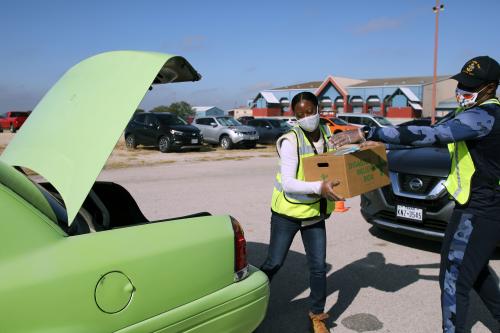Politics have finally caught up to the idea for a Civilian Climate Corps (CCC). Since President Joe Biden took office, momentum for a CCC has increased exponentially, with nearly a dozen bills related to the expansion of national service or using a corps model to address climate change introduced in Congress over the last year.
The Biden administration is also supportive, calling for a CCC in a January executive order and including $10 billion over 10 years for a CCC in next year’s budget. And now, a CCC is one of the programs under consideration as the White House and Congress develop the budget reconciliation package.
The need for a CCC could not be clearer, as the nation experiences a confluence of environmental, economic, and social disasters. The science shows that we need to take action now to address climate change or face a future of costly, deadly disasters. Meanwhile, the labor market is volatile and uncertain, especially for young people, people of color, and those with only a high school diploma or less. For decades, the United States has profoundly failed to provide sufficient guidance and support to millions of young people transitioning to adulthood, leaving them facing two bad choices: an expensive, confusing postsecondary landscape or a labor market largely offering low-wage jobs.
A Civilian Climate Corps can address each of these conditions by greening our cities, confronting a backlog of maintenance on public lands, providing a pathway to good jobs with paid work experience that builds skills and social networks, making higher education more accessible, and prioritizing young people and those on the economic margins in recruitment.
But describing these outcomes is not the same as achieving them. For a CCC to be effective, Congress and the White House must be strategic regarding program design and implementation.
What is a Civilian Climate Corps and what would it do?
In a corps model, members work on projects providing clear societal value, such as tutoring children, building affordable housing, maintaining public works, or assisting with disaster response. In return, members earn a modest living allowance, gain valuable work experience, build skills, and receive a small educational scholarship after completing their term of service.
AmeriCorps is perhaps the most well-known corps program, but other organizations also operate corps initiatives (sometimes with AmeriCorps funding). The network of service and conservation corps and programs such as YouthBuild have decades-long track records, supported partially through agreements with agencies such as the National Park Service and the U.S. Fish and Wildlife Service, as well as grants from the Department of Labor.
A Civilian Climate Corps would put people to work across the country—in rural, suburban, and urban communities alike, and in a variety of environment-related projects. In the spirit of the Civilian Conservation Corps of the 1930s, CCC members might work in national parks and other remote areas to build trails or restore wetlands. There is also no shortage of work in more populated areas, where CCC members could build green infrastructure to reduce stormwater runoff and flooding, or retrofit homes to be more energy-efficient.
The list of potential projects is endless, and many are documenting what those efforts might include. Moreover, the bipartisan Infrastructure Investment and Jobs Act, if enacted, will create demand for workers in an array of occupations, including engineering, construction, maintenance, and even marketing for climate-oriented programs. A CCC could serve as a pipeline to increase the flow of talent qualified for these positions and more generally act as a starting point for a great career.
The core principles that should shape the CCC
While there is broad agreement among the Democratic caucus that a CCC is a worthy investment, the outlines of the program remain fuzzy. Regardless of its final form, a CCC should incorporate a set of core principles that draw from the priorities of multiple communities, including proponents of national service and other corps programs, those building better opportunities for young adults with tenuous connections to school and jobs, and the environmental movement.
- The CCC must center racial and gender equity in its structure, operations, and goals. One of President Biden’s first actions after he took office was to issue an executive order on advancing racial equity and support for underserved communities. And in the American Jobs Plan, Biden described the creation of a CCC as putting “a new, diverse generation of Americans to work conserving our public lands and waters, bolstering community resilience, and advancing environmental justice.”
The environmental movement is predominantly white, and fair or not, one of the critiques of national service is that it disproportionately recruits and retains middle- and upper-middle-class white members. Meanwhile, low-income communities and communities of color have long experienced environmental racism and its hazards, such as exposure to air pollution and toxic waste, and now face a higher risk of death and displacement from climate change. It’s often these same communities that struggle to gain their footing in the labor market.
It must be a top, non-negotiable priority that a CCC recruit and retain members from lower-income families and communities of color. As Collin O’Mara of the National Wildlife Federation stated, “If [the CCC] is simply a gap year for college kids from the suburbs…we will have absolutely failed on every level.” - CCC projects should reflect the diversity of the country and its communities—and follow the lead of locally developed priorities. While the Depression-era Civilian Conservation Corps is associated most closely with remote areas and public lands, a new CCC must have a broader scope. Urban and suburban areas also need community development, increased climate resilience, and employment opportunities. Since different places have different assets, needs, and priorities, local leadership should have a major say in how projects are developed and implemented. And to center gender and racial equity, it should be standard operating procedure to recruit local residents as CCC members.
- CCC members should earn enough to live on. AmeriCorps is often used as a benchmark for corps programs, but its living allowance is roughly the equivalent of the poverty line (about $12,880 for a person living alone). In earlier work, we recommended AmeriCorps living allowances increase to at least 175% of the federal poverty level (about $22,540 per year for a single person). More recent proposals have recommended wages of at least $15 per hour, equivalent to just over $31,000 per year for full-time work. Another option is to use regional living wage estimates as the benchmark, so that workers earn enough to cover their basic living costs; in most places, this will be more than $15 per hour. Otherwise, we recommend going beyond our previous recommendation of pegging wages or living allowances to the poverty line, and setting them at $15 per hour, since that amount more closely approximates a living wage.
- Programs need sufficient resources and capacity to provide guidance, supportive services, and corps-specific training. Part of the corps model is preparing members for their next educational and employment steps. This can involve training, mentoring, leadership, personal development, and assistance with practical issues such as transportation. If the CCC is to truly reach a diverse range of workers, it needs different programming and more resources than if it only engaged with the most advantaged and career-ready individuals. Some people will need to earn their GED or improve their reading and math skills (regardless of whether they have a high school degree). Some will be less familiar than others with the norms of the working world or may need referrals for assistance with housing and other basic needs.
- CCC programs should embed themselves within regional labor markets and education/training systems to provide pathways to careers. CCC programs should not leave members planning their job searches and education to start from scratch after they finish. Instead, a CCC should work with employers, workforce boards, community colleges, and public universities to align their own training and projects with occupational and educational pathways in the region. For example, when appropriate, corps programs should function as pre-apprenticeships that feed into area apprenticeship programs. Members should also have consistent access to mentors, career counselors, and industry contacts to help them understand their options and build the professional networks that are important in finding a job.
- A CCC should provide meaningful financial assistance toward postsecondary education or training. Currently, AmeriCorps offers members who work at least 1,700 hours over a one-year period an education award equal to about $6,300. Given rising tuition costs, this award now only covers about two-thirds of the average in-state tuition at a public university—and that’s pre-tax. The education award is simply not big enough to achieve its goal of making postsecondary education more accessible and affordable. Recommendations to increase the award range from providing enough funding for two years in-state tuition or providing $25,000 per year of service, up to $50,000. Regardless, the education grant should also be exempted from federal and state taxes, as are other scholarships and federal awards.
The CCC demands a whole-of-government approach
The parallels between today and the conditions during the founding of the Depression-era Civilian Conservation Corps are striking: mounting ecological and infrastructure challenges combined with a population of prime-age workers who are out of work or marginally employed because of structural, macroeconomic forces.
The Civilian Conservation Corps was a public sector employment program that targeted the long-term unemployed through an interagency partnership between the departments of Labor, War, Interior, and Agriculture, with a separate division targeting Native Americans. A new Civilian Climate Corps would benefit from a similar interagency structure, with a focus on creating equitable access to paying work for those with barriers to the labor market.
Since 1993, AmeriCorps (formerly known as the Corporation for National and Community Service) has been the hub of domestic national service efforts. AmeriCorps is the rightful coordinating body for a new CCC, but it would be a mistake to limit the CCC to AmeriCorps’ parameters. On its own, AmeriCorps may not be able to quickly scale as envisioned in the congressional reconciliation legislation. Other agencies and program models have the proven capacity to help a CCC reach its goals, and can ensure that CCC participants reflect populations of particular concern to the Biden administration, including those with criminal records, the long-term unemployed, and young people who are out of school and out of work.
The Department of Labor, for example, has expertise in operating programs that combine rapid attachment to work with skill development and wraparound services. The Workforce Innovation and Opportunity Act (WIOA), administered by the department, authorizes the creation of transitional job programs—an ideal model for accomplishing the goal of a CCC. YouthBuild is another WIOA program whose goals and program design mesh well with the CCC. The Department of Labor can also support linkages with apprenticeship programs.
The Department of Agriculture and Department of the Interior—the original administrators of Civilian Conservation Corps projects—should be involved in the new CCC as well. The expertise in conservation and public lands management in department agencies such as the Bureau of Land Management, the U.S. Forest Service, and the National Park Service will ensure shovel-ready projects for CCC members.
The Department of Housing and Urban Development and the Department of Transportation are also critical agencies for a CCC. Public housing authorities around the country already fund jobs programs for young people and others on the outskirts of the labor market. Some national models for green jobs programs, such as Green City Force, rely on residents of public housing for their projects and have long-standing relationships with these agencies. The Department of Transportation is implicated in billions of dollars’ worth of projects from the Infrastructure Investment and Jobs Act, which can spin off myriad CCC initiatives. To avoid displacing regular workers, other agencies should be subject to anti-displacement rules that restrict members from supplanting employed workers or volunteers, as is required of AmeriCorps.
Regardless of which agencies run the CCC, there should be plenty of room for partnerships with nonprofit transitional jobs programs, social enterprises, and other organizations with CCC-aligned missions, such as electronic waste recycling and outdoor maintenance. These organizations are often best positioned to provide pathways into the labor market for individuals who would otherwise remain on the economic margins.
As Congress irons out the details of the reconciliation bill, it must ensure the relevant agencies receive sufficient funding to allow for equitable access to the benefits of a CCC, and a robust set of projects that will advance the national interest.
The CCC could bring forth generational change
With a new Civilian Climate Corps, the country can address the climate crisis and labor market dysfunctions that it has ignored for decades—and create an opportunity for a once-in-a generation investment.
The Biden administration’s 2022 budget includes $10 billion over 10 years for a CCC, while the most ambitious proposals have called for as much as $132 billion over five years. Under any scenario that centers gender and racial equity and higher pay, though, it’s clear that a $10 billion investment over 10 years is not enough. Fortunately, signals from the White House indicate support for a bigger number.
Based on a stipend equal to 175% of the federal poverty line and a $12,000 education award, we estimate that $10 billion dollars could result in—at most—just under 200,000 total new positions across the 10-year investment. Under the most robust expansion of the living stipend and education award (including a $15 minimum wage and $25,000 education award), that number would almost certainly be fewer than 100,000 positions. For each additional $10 billion, we estimate a CCC could add between 175,000 and 285,000 service positions.
The payoff is worth the price tag. AmeriCorps evaluations are instructive: A recent analysis found that for each dollar the federal government spends on AmeriCorps programs, it receives $3.50 in tax revenue gains and savings. And when benefits to communities and corps members are included, the return balloons to more than $17 in benefits for every federal dollar spent. Research has also found that the rate of return increases as more funding is funneled to these programs.
Funding a CCC at anything less than $25 billion to $35 billion over 10 years is a missed opportunity to invest in a model with a high ROI, improve the environmental resiliency of our communities, provide a badly needed bolster to the aging infrastructure workforce, and build on-ramps to quality careers for the many young people our economy leaves behind.
As President Franklin D. Roosevelt, creator of the Civilian Conservation Corps, wrote, this work “will conserve our precious natural resources. It will pay dividends to the present and future generations. It will make improvements in national and state domains which have been largely forgotten in the past few years of industrial development…It is not a panacea for all the unemployment but it is an essential step in this emergency.”








Commentary
Biden and Congress should go big on a Civilian Climate Corps to restore the environment and provide good jobs
September 15, 2021